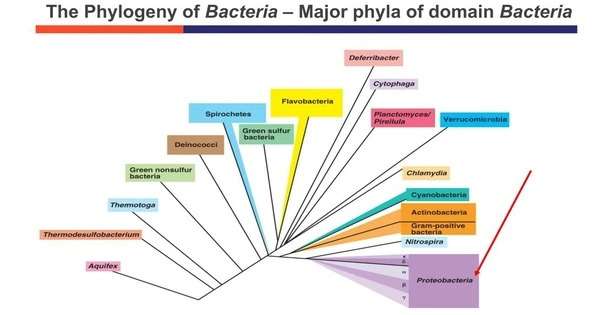Bacterial phyla are broad categories of bacteria based on genetic similarity and evolutionary history. It is one of the most important lineages in the Bacteria domain. A bacterial phylum is a monophyletic lineage of bacteria having 16S rRNA genes that have a pairwise sequence identity of ~75% or less than those of other bacterial phyla, though the exact definition is contested. They help to classify and comprehend the diversity of microorganisms.
It is estimated that there are over ~1,300 bacterial phyla. As of May 2020, the LPSN has formally approved 41 bacterial phyla, the Silva database recognizes 89 bacterial phyla, dozens more have been proposed, and hundreds are likely to be discovered. As of 2017, around 72% of generally recognized bacterial phyla were candidate phyla (meaning there were no cultivated representatives).
Some of the major bacterial phyla include:
- Proteobacteria: This is one of the largest and most diverse bacterial phyla, encompassing a wide range of bacteria including many well-known pathogens such as Escherichia coli and Salmonella, as well as beneficial bacteria like Rhizobium which fix nitrogen in the soil.
- Firmicutes: This phylum includes bacteria with a thick, rigid cell wall such as Bacillus and Clostridium species. Many Firmicutes are important in industry, agriculture, and medicine.
- Actinobacteria: Actinobacteria are known for their filamentous growth and include many important genera such as Streptomyces, which produce antibiotics, and Mycobacterium, which includes the causative agents of diseases like tuberculosis and leprosy.
- Bacteroidetes: These bacteria are commonly found in the human gut where they play important roles in breaking down complex carbohydrates and contributing to host health.
- Cyanobacteria: Often referred to as blue-green algae, Cyanobacteria are photosynthetic bacteria that play a crucial role in the oxygenation of the Earth’s atmosphere. They can be found in a variety of environments including freshwater, marine, and terrestrial habitats.
- Spirochaetes: Spirochaetes are characterized by their spiral shape and include pathogens such as Treponema pallidum, which causes syphilis, and Borrelia burgdorferi, the causative agent of Lyme disease.
- Chloroflexi: These bacteria are often found in aquatic environments and include species capable of anoxygenic photosynthesis.
These are just a few examples, and there are many more bacterial phyla, each with their own unique characteristics and ecological roles.
















